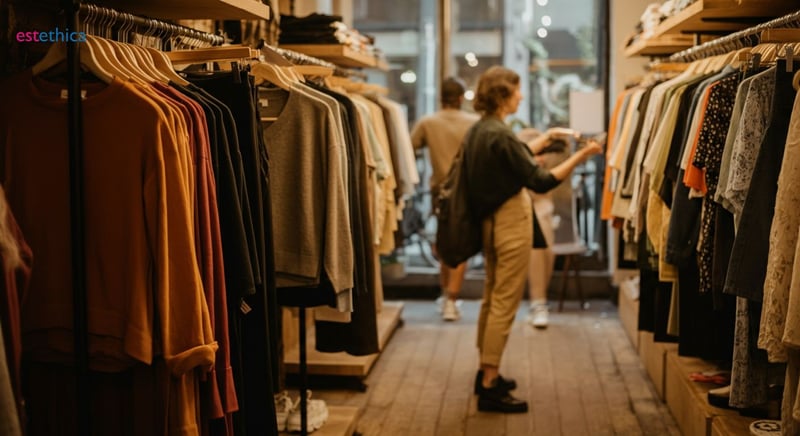Discovering the Future of Eco-Friendly Fashion
Explore eco-friendly fashion innovations shaping an ethical and sustainable future in fashion.
Explore the Innovations Leading to a Sustainable Fashion Future
The realm of sustainable fashion transcends mere trendiness, offering a profound solution to the environmental challenges posed by the fashion industry. As increasing awareness of eco-friendly clothing emerges, understanding the intricacies behind ethical fashion brands becomes imperative. With global consumers advocating for eco-conscious lifestyles and green consumerism, the shift towards sustainable fashion marks a pivotal moment for both industry insiders and consumers alike.
Understanding Sustainable Fashion: A Beginner's Guide
Exploring the Aesthetics of Sustainable Fashion
Sustainable fashion is not just about reducing environmental impact; it also embraces unique aesthetics that appeal to modern consumers. The visual aesthetics of eco-friendly clothing often highlight natural textures and earthy tones, creating a distinct style that sets it apart from conventional fashion. For instance, garments made from organic cotton or recycled materials often feature a raw, unrefined look that resonates with those seeking authenticity in their wardrobe choices. Additionally, the aesthetics rn (right now) of sustainable fashion emphasize minimalism and timeless designs, ensuring that pieces remain stylish across seasons.
How to Choose Sustainable Fashion
- Research ethical fashion brands that prioritize sustainability in their production processes.
- Look for certifications like Fair Trade or GOTS to ensure eco-friendly clothing practices.
- Consider the lifecycle of the garment, from sourcing to disposal, to make informed choices.
By understanding these steps, consumers can align their purchases with green consumerism values, supporting brands that prioritize ethical and sustainable practices.
Key Features of Sustainable Fashion
- Use of sustainable textile innovations, such as biodegradable fabrics.
- Incorporation of upcycled clothing, reducing waste and promoting circular fashion.
- Commitment to ethical labor practices, ensuring fair wages and safe working conditions.
These features not only contribute to a more sustainable industry but also offer consumers the opportunity to make ethical wardrobe choices that reflect their values.

Choosing the Best Eco-Friendly Clothing Materials
Exploring the Aesthetic Appeal of Eco-Friendly Fabrics
Eco-friendly clothing materials like organic cotton, bamboo, and hemp offer unique aesthetic qualities that appeal to conscious consumers. The visual aesthetics of these fabrics often feature natural textures and earthy tones, providing a distinct style that aligns with sustainable fashion trends. For example, organic cotton garments showcase a soft, breathable texture, while bamboo fabric offers a silky, smooth finish. Hemp, known for its durability, presents a rustic charm that resonates with those seeking authenticity in their wardrobe. These materials not only contribute to a green fashion statement but also ensure that the aesthetics rn (right now) remain timeless and versatile.
Steps to Identify the Best Eco-Friendly Clothing Materials
- Examine the fabric's source to ensure it is sustainably grown and harvested.
- Check for certifications like GOTS or OEKO-TEX, which guarantee eco-friendly practices.
- Consider the biodegradability of the material to minimize landfill contributions.
By following these steps, consumers can make informed decisions that support sustainable apparel choices and ethical fashion brands.
Benefits of Choosing Eco-Friendly Clothing Materials
- Reduced environmental impact through sustainable farming and production methods.
- Enhanced comfort and breathability due to natural fibers.
- Support for ethical labor practices and fair trade initiatives.
These benefits not only promote green consumerism but also contribute to a more sustainable and ethical fashion industry.

How to Identify Ethical Fashion Brands
Understanding the Aesthetics of Ethical Fashion
Ethical fashion brands often embrace aesthetics that reflect their commitment to sustainability and fair practices. The visual aesthetics of these brands typically highlight simplicity and elegance, with a focus on timeless designs that transcend fleeting trends. For example, brands like People Tree and Patagonia emphasize clean lines and neutral palettes, creating pieces that are both stylish and sustainable. The aesthetics rn (right now) in ethical fashion also prioritize functionality, ensuring that garments are not only beautiful but also practical for everyday wear. This approach resonates with consumers who value both style and substance in their wardrobe choices.
Steps to Identify Ethical Fashion Brands
- Research the brand's supply chain transparency to ensure ethical sourcing and production.
- Look for certifications such as Fair Trade or GOTS that validate sustainable practices.
- Evaluate the brand's commitment to fair labor practices and worker well-being.
By following these steps, consumers can support brands that align with their values and contribute to a more ethical fashion industry.
Key Characteristics of Ethical Fashion Brands
- Commitment to transparency in the supply chain, ensuring ethical sourcing and production.
- Focus on fair labor practices, providing safe working conditions and fair wages.
- Emphasis on sustainable materials and eco-friendly production methods.
These characteristics not only define ethical fashion brands but also offer consumers the opportunity to make informed choices that reflect their commitment to sustainability and social responsibility.

Exploring Sustainable Fashion Innovations
The Role of Technology in Sustainable Fashion
Technology is revolutionizing sustainable fashion by introducing innovative solutions that minimize waste and enhance eco-friendly clothing production. For instance, 3D printing allows designers to create garments with precision, reducing fabric waste significantly. Additionally, digital fashion platforms enable virtual try-ons, decreasing the need for physical samples and returns. These advancements not only contribute to sustainable apparel but also align with the aesthetics rn (right now) by offering unique, customizable designs that appeal to modern consumers.
Innovative Practices in Sustainable Fashion
- Zero waste fashion techniques, such as pattern-making that utilizes every inch of fabric.
- Adoption of biodegradable materials that break down naturally, reducing landfill impact.
- Upcycling discarded clothing into new, stylish pieces, promoting circular fashion.
These practices not only enhance the visual aesthetics of sustainable fashion but also ensure that the industry moves towards a more environmentally responsible future.
Steps to Implement Sustainable Fashion Innovations
- Invest in research and development to explore new sustainable materials and technologies.
- Collaborate with tech companies to integrate digital solutions into fashion production.
- Educate consumers on the benefits of sustainable fashion innovations to drive demand.
By following these steps, brands can effectively incorporate sustainable fashion innovations, ensuring that their offerings are both eco-friendly and aesthetically appealing.
Innovative Sustainable Fashion Technologies
Excellence in Sustainable Fashion Processes
Frequently Asked Questions
What is sustainable fashion and why is it important?
How can I identify ethical fashion brands?
What are the benefits of choosing eco-friendly clothing materials?
What role does technology play in sustainable fashion?
What are some key features of sustainable fashion?
Discover the path to your healthiest and most beautiful self with estethica's award-winning services. Contact us today for a free consultation and experience the highest standards of care and innovation.
📞 Call Now for Your Free Consultation